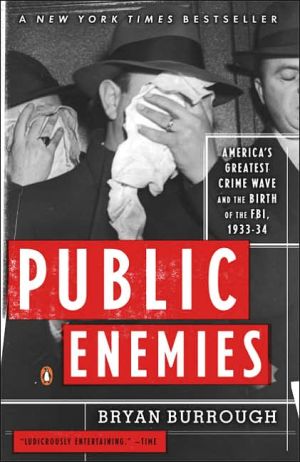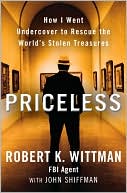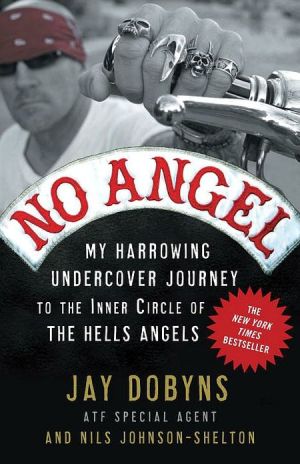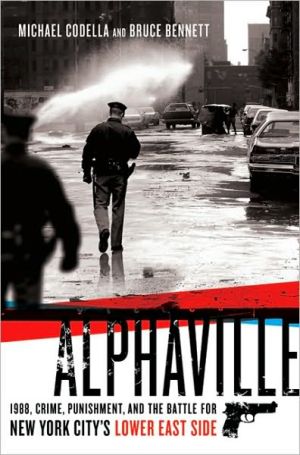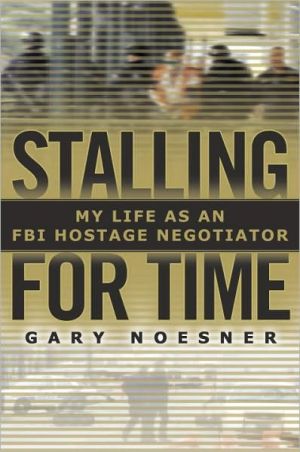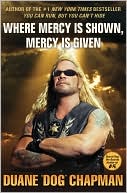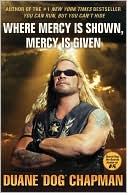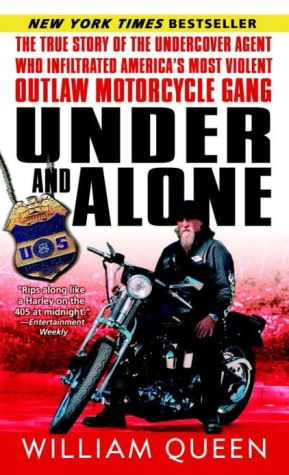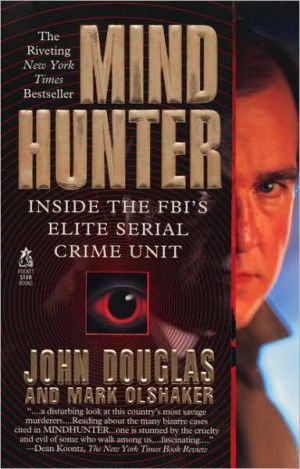Public Enemies: America's Greatest Crime Wave and the Birth of the FBI, 1933-34
In Public Enemies, bestselling author Bryan Burrough strips away the thick layer of myths put out by J. Edgar Hoover’s FBI to tell the full story—for the first time—of the most spectacular crime wave in American history, the two-year battle between the young Hoover and the assortment of criminals who became national icons: John Dillinger, Machine Gun Kelly, Bonnie and Clyde, Baby Face Nelson, Pretty Boy Floyd, and the Barkers. In an epic feat of storytelling and drawing on a remarkable amount...
Search in google:
Burrough (a special correspondent for Vanity Fair) examines the stories of John Dillinger, Baby Face Nelson, Pretty Boy Floyd, the Barker-Karpis Gang, Machine Gun Kelly, and Bonnie and Clyde as a single narrative history of the FBI's "War on Crime" from 1933 to 1936. His examination of the recently release FBI files reveals a story vastly different from the largely mythical narrative promoted by J. Edgar Hoover or the romantic portrayals of the gangs by Hollywood. For Burrough, the story is about the bureaucratic evolution of the FBI from a bungling group of amateurs to a professional crime-fighting organization and his central aim is to reclaim the history for the individual agents involved. Annotation ©2004 Book News, Inc., Portland, OR The New York Times - Mark Costello Burrough, a special correspondent for Vanity Fair and the author of Barbarians at the Gate, has written a book that brims with vivid portraiture. His Dillinger is haunting, a figure out of the fiction of Richard Ford, a man of meanness and sorrow and deep rural pessimism … As the story of the F.B.I.'s emergence from the 10-ring circus that was 1934, Public Enemies is excellent true crime with all the strengths and limitations this implies.
Torremolinos, Spain August 26, 1979\ In a tourist town on the white-sun Spanish coast an old man was passing his last years, an American grandfather with a snowy white crew cut and a glint in his turquoise eyes. At seventy he was still lean and alert, with high-slanting cheekbones, a sharp chin, and those clear-framed eyeglasses that made him look like a minor-league academic. He spent much of his time holed up in his cluttered garage apartment, watching BBC footage of the Iranian hostage crisis on a flickering black-and-white television, surrounded by bottles of Jack Daniel’s and pills and memories. If you met him down on the beach, he came across as a gentle soul with a soft laugh. Almost certainly he was the most pleasant murderer you’d ever want to meet.\ It was sad, but only a little. He’d had his fun. When he’d first come to Spain ten years before, he still knew how to have a good time. There was that frowsy old divorcée from Chicago he used to see. They would go tooling around the coast in her sports car and chug tequila and down their pills and get into these awful screaming fights.\ She was gone now. So were the writers, and the documentary makers, the ones who came to hear about the old days; that crew from Canada was the worst, posing him in front of roadsters and surrounding him with actors in fedoras holding fake Tommy guns. He’d done it for the money and for his ego, which had always been considerable. Now, well, now he drank. Out in the cafés, after a few beers, when the sun began to sink down the coast, he would tell stories. The names he dropped meant little to the Spaniards. The Brits and the odd American thought he was nuts, an old lush mumbling in his beer.\ When he said he’d been a gangster, they smiled. Sure you were, pops. When he said he’d been Public Enemy Number One—right after John Dillinger, Pretty Boy Floyd and his old protégé Baby Face Nelson—people turned away and rolled their eyes. When he said he and his confederates had single-handedly “created” J. Edgar Hoover and the modern FBI, well, then he would get bitter and people would get up and move to another table. He was obviously unstable. How could you believe anyone who claimed he was the only man in history to have met Charles Manson, Al Capone, and Bonnie and Clyde?\ Few in Torremolinos knew it was all true. In those last years at Terminal Island in the sixties he’d taught Manson to play the steel guitar. He’d been at Alcatraz for twenty-one damp winters before that, leaving for Leavenworth a few years before they closed the place in 1963. In fact, he was the longest-serving prisoner in the history of The Rock. He’d known the Birdman and that gasbag Machine Gun Kelly and he’d seen Capone collapse into one of his syphilitic seizures, flopping around on the cafeteria floor like a striped bass on a cutting board.\ In his day he’d been famous. Not fifteen-minutes famous but famous-famous, New York Times-page-one-above-the-fold famous. Back before Neil Armstrong, before the Beatles, before American Bandstand, before the war, when Hitler was still a worrisome nut in a bad mustache and FDR was learning to find the White House bathrooms, he was the country’s best known yeggman. Folks today, they didn’t even know what a yegg was. Dillinger, he liked to say, he was the best of yeggs. Pretty Boy Floyd was a good yegg. Bonnie and Clyde wanted to be.\ And today? Today he and all his peers were cartoon characters, caricatures in one bad gangster movie after another. You could see them on the late show doing all sorts of made-up stuff, Warren Beatty as some stammering latent homosexual Clyde Barrow, Faye Dunaway as a beautiful Bonnie Parker (now that was a stretch), Richard Dreyfuss as a chattering asshole Baby Face Nelson (okay, they got that right), Shelley Winters as a machine-gun toting Ma Barker, a young Robert De Niro as one of her sons. To him they were all ridiculous Hollywood fantasies, fictional concoctions in a made-up world.\ At that point the old man would just shake his head. As he sat on his couch at night, sipping his Jack Daniel’s and popping his pills, what galled him was that it had all been real. It had all happened. Not in some fantasy world, not in the movies, but right there in the middle of the United States, in Chicago, in St. Paul, in Dallas, in Cleveland.\ And the truth of it, the actual true facts, was all but lost now, forgotten as totally as he was. Dillinger, Floyd, Nelson, Bonnie and Clyde, Ma Barker: He had known them every one. He was the last one left alive. He had even outlived Hoover himself.\ Hoover.\ Fucking Hoover.\ He leaned over and reached for a bottle of his pills.
Author's NotexiCast of CharactersxvPrologue11A Prelude to War, Spring 193352A Massacre by Persons Unknown, June 8 to June 15, 1933193The College Boys Take the Field, June 17 to July 22, 1933514The Baying of the Hounds, July 22 to August 25, 1933715The Kid Jimmy, August 18 to September 25, 1933986The Streets of Chicago, October 12 to November 20, 19331357Ambushes, November 20 to December 31, 19331628"An Attack on All We Hold Dear," January 2 to January 28, 19341839A Star Is Born, January 30 to March 2, 193420610Dillinger and Nelson, March 3 to March 29, 193423411Crescendo, March 30 to April 10, 193426712Death in the North Woods, April 10 to April 23, 193429213"And It's Death for Bonnie and Clyde," April 23 to May 23, 193432314New Faces, May 24 to June 30, 193436215The Woman in Orange, July 1 to July 27, 193438816The Scramble, July 23 to September 12, 193441717A Field in Ohio and a Highway in Illinois, September 18 to November 27, 193444618The Last Man Standing, December 3, 1934, to January 20, 193548419Pas de Deux, January 1935 Until...515Epilogue543Bibliographical Essay553Notes556Selected Bibliography567Acknowledgments571Index573
\ From Barnes & NobleThe men and women at the center of this book are American legends: John Dillinger, Bonnie and Clyde, Baby Face Nelson, Pretty Boy Floyd, the Barker gang, and "G-Man" J. Edgar Hoover have all become part of our national folklore. Bryan Burrough's Public Enemies strips away Depression-era myths to reveal the even more fascinating truth about America's most spectacular crime wave and the birth of the Federal Bureau of Investigation. The Vanity Fair correspondent uses newly released official files and other material to create an action-packed yet analytical narrative about the evolving warfare between lawmen and lawbreakers. Exposing the blunders and narrow misses of the tenderfoot FBI, he describes how Hoover cobbled together the Bureau's lofty public image from less-than-perfect performances. A first-rate read.\ \ \ \ \ Mark CostelloBurrough, a special correspondent for Vanity Fair and the author of Barbarians at the Gate, has written a book that brims with vivid portraiture. His Dillinger is haunting, a figure out of the fiction of Richard Ford, a man of meanness and sorrow and deep rural pessimism … As the story of the F.B.I.'s emergence from the 10-ring circus that was 1934, Public Enemies is excellent true crime with all the strengths and limitations this implies. \ — The New York Times\ \ \ Publishers WeeklyBurrough, an award-winning financial journalist and Vanity Fair special correspondent, best known for Barbarians at the Gate: The Fall of RJR Nabisco, switches gears to produce the definitive account of the 1930s crime wave that brought notorious criminals like John Dillinger and Bonnie and Clyde to America's front pages. Burrough's fascination with his subject matter stems from a family connection-his paternal grandfather manned a roadblock in Arkansas during the hunt for Bonnie and Clyde-and he successfully translates years of dogged research, which included thorough review of recently disclosed FBI files, into a graceful narrative. This true crime history appropriately balances violent shootouts and schemes for daring prison breaks with a detailed account of how the slew of robberies and headlines helped an ambitious federal bureaucrat named J. Edgar Hoover transform a small agency into the FBI we know today. While some of the details (e.g., that Dillinger got a traffic ticket) are trivial, this book compellingly brings back to life people and times distorted in the popular imagination by hagiographic bureau memoirs and Hollywood. Burrough's recent New York Times op-ed piece drawing parallels between the bureau's "reinvention" in the 1930s and today's reform efforts to combat the war on terror will help attract readers looking for lessons from history. Agent, Andrew Wylie. 6-city author tour. (July 22) Copyright 2004 Reed Business Information.\ \ \ \ \ Library JournalBurrough (coauthor, Barbarians at the Gate: The Fall of RJR Nabisco) is clearly a gifted writer and a skilled researcher. Yet while many of the vignettes in this portrait of a crime era read like the best fiction, the book suffers from considerable back and forth and ends up a disappointing, disjointed affair. Just when the reader starts turning pages faster as the FBI begins to move in on Baby Face Nelson, Burrough switches to the hunt for John Dillinger. However colorful, the various gang members become harder and harder to distinguish, and the uninitiated will find themselves confused by the seemingly bland recitation of FBI agents complete with birth date, service dates, etc. and the criminals they pursued. With so much material, including recently released FBI files, Burrough could easily have filled twice the pages. In fact, he intends this to be serious history and rails against the Hollywood treatment afforded these murderous criminals, yet he, too, is guilty of sensational writing. Of interest mainly to true fans. Karen Sandlin Silverman, CFAR-Ctr. for Applied Research, Philadelphia Copyright 2004 Reed Business Information.\ \ \ \ \ Kirkus ReviewsA rollicking, rat-a-tat ride with Clyde Barrow, Ma Barker, and a raft of inept (but a few first-rate) G-men. Though J. Edgar Hoover argued otherwise-and wrote gainsayers out of the official histories-his fledgling FBI was a thoroughly politicized bureaucracy just like any other, torn by rivalries and full of guys who just couldn't handle the work. (And so, it appears from recent testimonials before Congress, it remains.) Hoover's agents were ill-equipped to handle the flood of violent crime that washed over the nation in the first years of FDR's administration-which, Vanity Fair correspondent Burrough notes, "wasn't the beginning of a crime wave, it was the end of one." Where bank robbery had been comparatively rare, those years saw an explosion of attacks across the country, mostly in rural settings; committed by men and women such as Bonnie Parker, John Dillinger, and Machine Gun Kelly, they met with public understanding, if not approbation, for the economy had tanked, and the public blamed bankers for the hardships they now had to endure. Part of Hoover's mission in declaring open warfare on these criminals, writes Burrough, was to battle "the idea of crime, the idea that too many Americans had come to tolerate crime." Given the celebrity that the likes of Ma Barker and Pretty Boy Floyd came to enjoy, Hoover surely had a point, even though he and his boys got it wrong much of the time; Ma Barker, to name one putative public enemy, decried as the murderous, machine-gun-spraying brains of a monstrous ring, "wasn't even a criminal, let alone a mastermind." But plenty of the people the G-men went after were criminals, sometimes even masterminds, and very dangerous, just as likely to gundown passersby as cops and bank dicks; as Burrough writes, Baby Face Nelson in particular lives up to his reputation: "a caricature of a public enemy, a callous, wild-eyed machine-gunner who actually laughed as he sprayed bullets toward women and children."Iconoclastic and fascinating. A genuine treat for true-crime buffs, and for anyone interested in the New Deal era. Agents: Andrew Wylie, Jeffrey Posternak/Wylie Agency\ \
